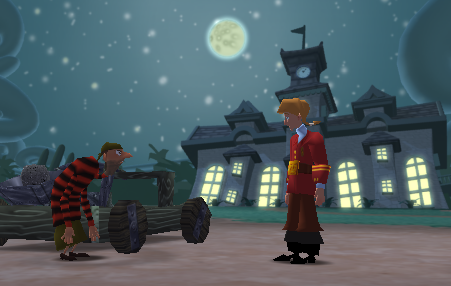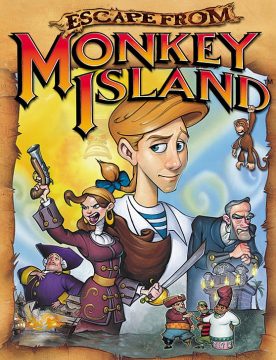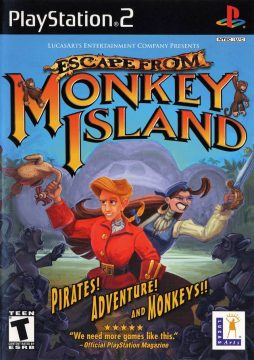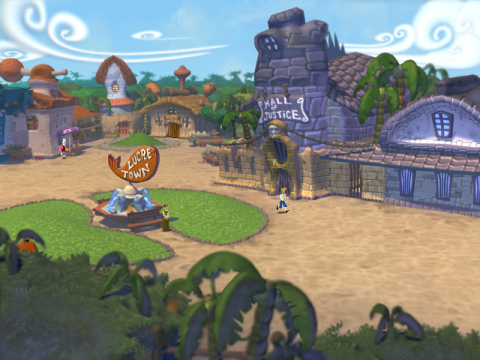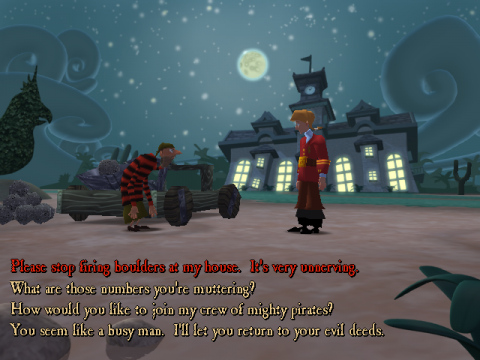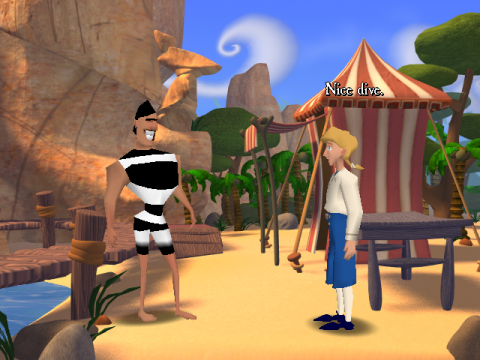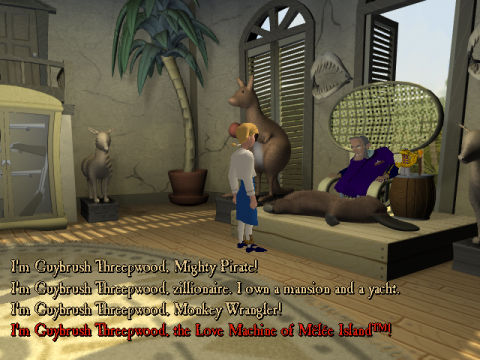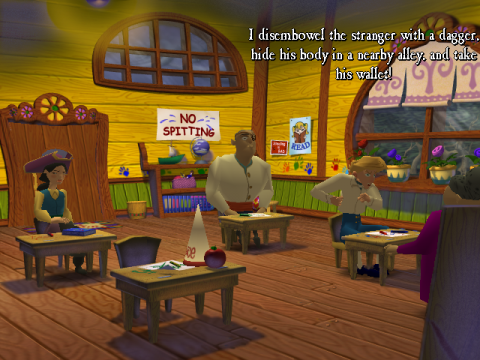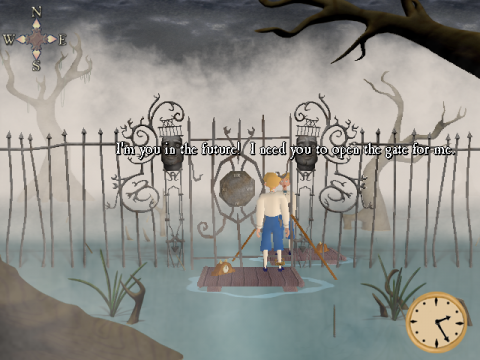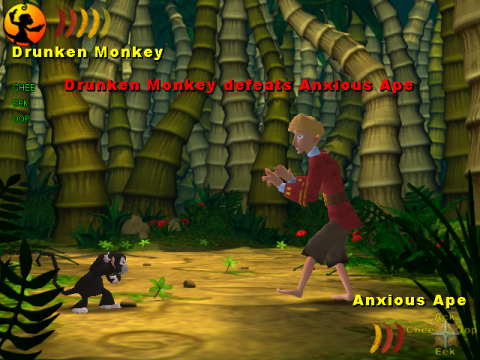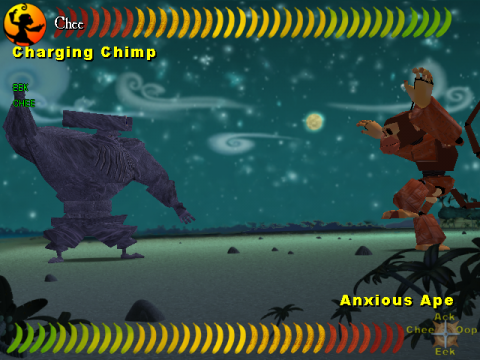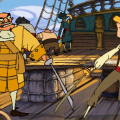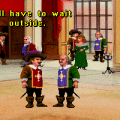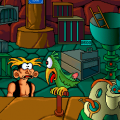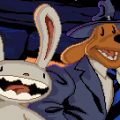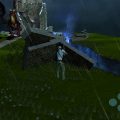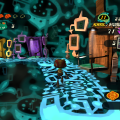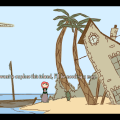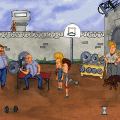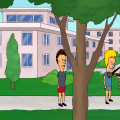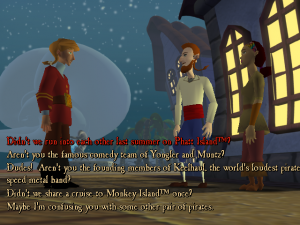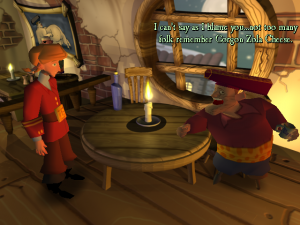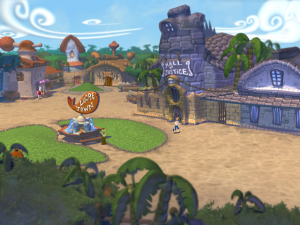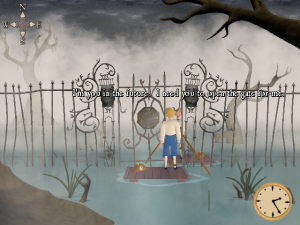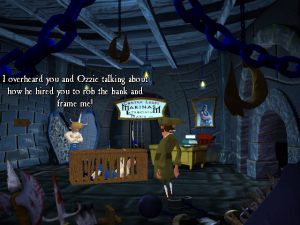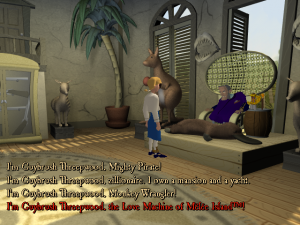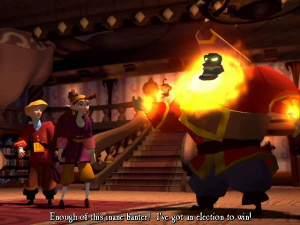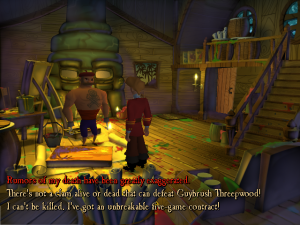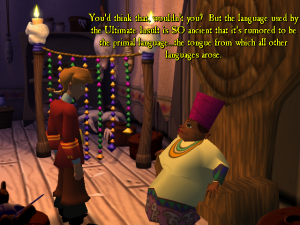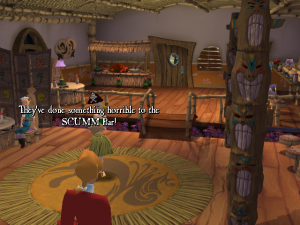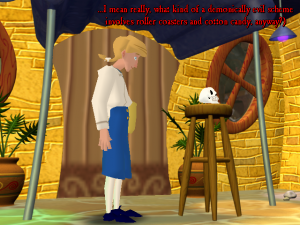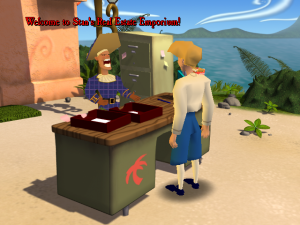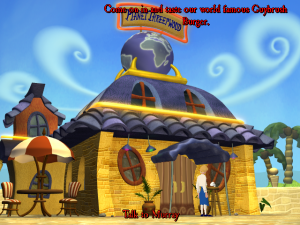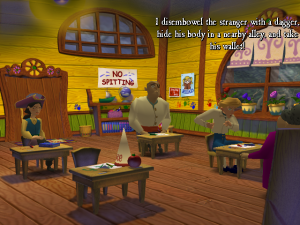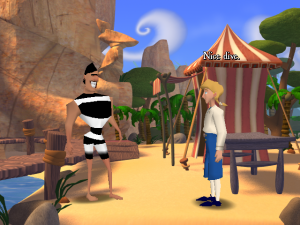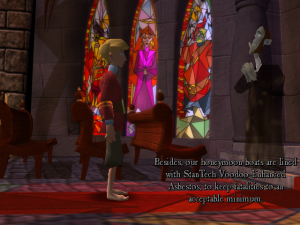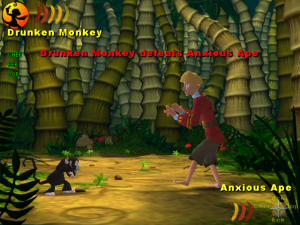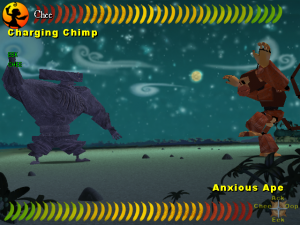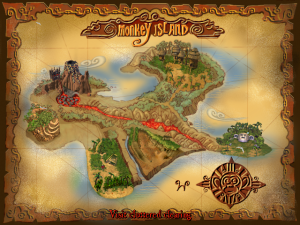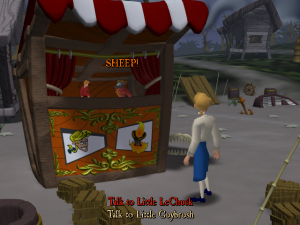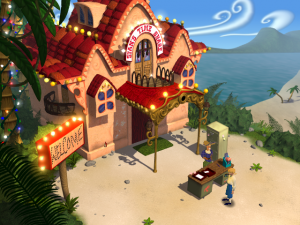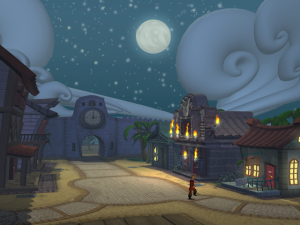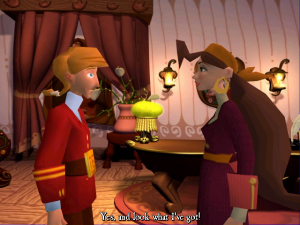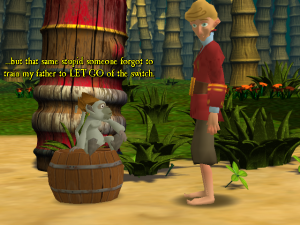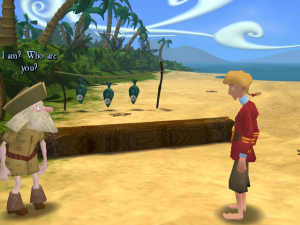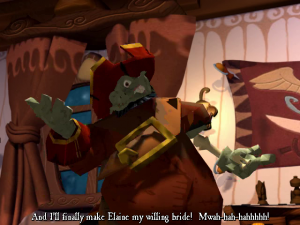The Curse of Monkey Island ended with Guybrush burying LeChuck under a glacier and finally marrying Elaine Marley. They spend a few months at sea on a honeymoon, only to return to Mêlée Island and find that the Governor has been declared legally dead. Guybrush sets off to find out why, only to run into an evil Australian real estate mogul named Ozzie Mandrill. His plans? Overhaul the entire Caribbean and turn it into a huge tourist trap, destroying the pirate populace and replacing it with family friendly restaurants and amusement park rides. His true plan, as it eventually unfurls, is to discover the Ultimate Insult, words in a language so ancient that they pierce directly into the soul and turn any mortal into a mortified shell of a man.
Meanwhile, Elaine is trying to prove herself not-dead, and runs for re-election against the mysterious Charles L. Charles, who is very clearly (ahem) not LeChuck in disguise. Guybrush first runs into trouble when he’s framed for a bank robbery and is detained on Lucre Island until he clears his name. Once he discovers all of the pieces of the Ultimate Insult on Jambalaya Island, he is captured by LeChuck and Ozzie, and sent back into the (not quite) terrifying jungles of Monkey Island. Guybrush must naturally escape and do what he must to save the dignity of all pirate-dom.
Escape from Monkey Island uses the GrimE engine, which was initially built for Grim Fandango. The point-and-click interface is also completely gone, replaced with an awkward direct control scheme. All of the backgrounds are pre-rendered, while the characters are all polygonal models, making it feel a bit more like Alone in the Dark and Resident Evil. There are options for both character-relative (the much loathed tank controls) or screen-relative (where up is always up regardless of the camera angle), but both are fiddly, and neither are completely comfortable. Interacting with objects is also a pain, since you either need to use different keys to look at or use different items, or use the Page Up/Down keys to cycle through multiple objects. This may shatter the soul of long-time PC gamers, but Escape from Monkey Island really is best played with a gamepad. At least there’s a feature which lets you immediately exit the screen you’re in.
The shift to 3D graphics may have seemed like an improvement when it was released, but time has taught us that it really wasn’t. The CG rendered backgrounds are pretty good, but the character models have a noticeably low polygon count. The angular look worked for the heavily stylized Grim Fandango, but it doesn’t quite pan out here. It’s particularly noticeable with Guybrush, especially his boxy hair, stiff movements, and nearly complete lack of facial animations. There are a lot of subtle actions in the 2D games that are completely lost here. Still, it looks better than some other 2D-to-3D transitions, like Gabriel Knight: Blood of the Sacred, Blood of the Damned and Simon the Sorcerer 3D. Visually, both of those were pretty bad, while Escape from Monkey Island is at least acceptable.
Still, the big draw of the game is seeing familiar locations remodeled in a more modern style and hearing the voices of familiar characters with voice acting. Roughly a third of the game takes place on Mêlée and Monkey Islands, which is good for a nostalgia kick, while the rest focuses on Lucre and Jambalaya Islands. Guybrush is once again voiced by Dominic Armato, while Elaine’s actress is different, with her British accent replaced by an American one. Some classic characters you’ll meet include Carla, Otis and Meathook, the mutinous crewmembers you abandoned on Monkey Island way back in the first game and are still dealing with the trauma, as well as the half-senile hermit Herman Toothrot, who’s the subject of some substantial retconning.
Escape from Monkey Island is largely regarded as the bastard of the series, and not just for the switch to 3D. The Curse of Monkey Island was criticized by some fans for being a bit too cartoony, but Escape from Monkey Island is even less restrained. Much of this change can be traced once again to the change in directors – this one is helmed by Sean Clark and Michael Stemmle, who previously worked on The Dig and Sam & Max Hit the Road. They’re still funny guys, but so much of this game is hit or miss.
The previous games seemed like they meant to take place around the 18th or 19th century, with bits of anachronisms thrown in for occasional humor. Escape from Monkey Island breaks through that completely, especially with its numerous parodies and pop culture references. The resort of Jambalaya Island is filled with places like Planet Threepwood (a play off the Planet Hollywood restaurant) as well as Starbuccaneers (naturally, Starbucks), and it’s the only Monkey Island game with an OJ Simpson reference (“If the nose fits, you must acquit!”) The wackiness escalates even further in the final segments, where you control a gigantic monkey robot. (This was apparently a discarded idea from the original game, and probably should’ve never left the cutting room floor. This whole segment was meant to be the “true secret of Monkey Island” as evidenced by the title of the cutscene, but most fans choose to ignore this.) The commentary on the effects of modern development and commercialism are amusing, but one can’t help but feel that it’s a drastic departure from the themes of its predecessors and feels somewhat out of place.
It doesn’t help that certain other elements just fall flat. Elaine Marley was never much of a presence in the previous games – she was more like a big sister figure, and the erratic romance between her and Guybrush was mostly played for laughs. Here, they’re married, and he’s completely henpecked (the game introduces him as Guybrush Marley-Threepwood), an overplayed trope that just isn’t very funny. (While Ron Gilbert has generally had nice things to say about the series after he left, he has expressed his disapproval over Guybrush and Elaine getting together.) Ozzie Mandrill isn’t particularly funny either. His only real distinguishing characteristics are being cranky and possessing a penchant for littering his speech with references to Australian animals. And pretty much everything relating to the Ultimate Insult (outside of its initial reveal) is just overplayed.
Many of the secondary characters lack much flair. Sure, it’s cool to run into old faces like Stan, the Voodoo Lady, and Murray, the latter of whom has been reduced to a (rather useless) bouncer, but the rest of the cast? There’s Ignatius Cheese, a man with a silly name and some food-related jokes similar to the Goodsoup family from The Curse of Monkey Island. There’s a cranky harbor mistress, a daft cannonball operator, and a snooty diving champion named Marco Pollo. A good chunk of people are simply brain dead tourists and clerks. Some of them are funny, which is largely due to the still-outstanding voice acting, but none are particularly memorable, and it’s unlikely we’ll ever see them again in future Monkey Island games.
That’s not to say the game is completely devoid of laughs though. There are still plenty of funny moments, some of the best coming from a Pirate Rehabilitation Center, which resembles an old schoolhouse. During a quiz, you’re given several hypothetical situations and how to react to them – the “correct” answers are the polite, amicable ones, but the “fun” ones (and the ones required to get an item to solve another puzzle) are the most ludicrously and unnecessarily violent responses. (“Your tofu burger is delivered medium well, despite your explicit request for medium rare. How do you react?” “I burn the restaurant to the ground, and string the chef up by his kidneys!”) The classic SCUMM Bar is taken over by Ozzie and turned into the Hawaiian-themed LUA Bar, a joke only total nerds will ever find amusing. (Both are scripting languages, the former obviously the one LucasArts used in its 2D games.)
Much of the laughs shine through with the puzzles, of course. Early in the game you need to navigate through the Mists O’ Time, which is a fairly simple puzzle, up until you meet your future self. He’ll say a few things and give you a few items. Once you proceed, you’ll eventually warp through time unknowingly and come across your past self – you need to repeat the exact same actions in the exact same order or else you’ll cause a time paradox. This scenario has popped up in a few other adventure games, like Legend’s text adventure Timequest and Adventure Soft’s Simon the Sorcerer II, but it’s never been quite this clever.
Some puzzles still prove irrational, per the rest of the series, even though they’re still funny. Near the beginning, you’ll come across a manhole with three different names written on it. Later, a shopkeeper at the prosthetics store will begin to tell a story and ask you to fill in the blanks with various names. Obviously, you’re supposed to pick the names you found on the manhole. This doesn’t remotely make sense, but the item he gives you – prosthetic skin – is used back by the sewer entrance, where you use it as a trampoline, tying it into one huge circle. More amusing is when you get the names wrong, which gives you some other useless prosthetic body part. Get enough of them and you can assemble them into another useless item called an Abomination of Nature.
Unlike the second and third Monkey Island, there’s only one difficulty level, and while there are some aggravating puzzles, it’s not quite as tough as either of the previous games’ hardest level. Their quality takes a nosedive once you reach Monkey Island in the last third of the game. First you need to roll rocks down a series of ledges, and time them so they bump into each other, launching them down different paths. It’s easy enough to figure out, but the timing is annoyingly touchy. Then you’re forced to navigate a log through a river of lava, which you’re practically required to do several times to get it right. And then, the game ends with the worst thing in the entire series – Monkey Kombat.
Monkey Kombat is this game’s variation on insult sword fighting. Basically, it’s like a complicated version of Rocks-Paper-Scissors, with a variety of kung fu stances which can defeat (or be defeated by) other stances. It’s not just enough to memorize these – you need to memorize the “insults” to switch positions, which are strings of monkey noises like “oop” and “chee”. The only way to get these is by, yup, repeatedly fighting monkeys over and over, until you gain enough experience and a long enough life bar to continue. The insult swordfighting bits from the first and third games were occasionally a bit annoying, but at least they were funny. This, not so much. Sure, someone probably thought the name was clever, and it’s a bit neat to see Guybrush executing hadoukens and shoryukens like the guys from Street Fighter II, but that’s not worth the exercise in tedium that it quickly becomes.
While Escape from Monkey Island has more than a fair share of flaws, it’s still an enjoyable game, as long as you can accept the change in tone and the occasional eye-rolling moment. It may be the weakest Monkey Island – and perhaps one of the weakest LucasArts adventures – but it’s still better than most others.
In 2002, Escape from Monkey Island was ported to the PlayStation 2. It looks almost identical, although the frame rate isn’t quite as smooth and there are brief load times during screen changes. Still, since it was essentially made for a gamepad in the first place, it controls pretty well and didn’t really lose much during the porting process. It also adds a concept artwork gallery and a guide during the Monkey Kombat sequences to make the whole thing slightly less painful.
